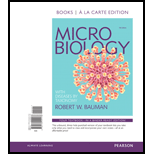
To determine:
The differences between the pathogenicity of coliform, noncoliform, and truly pathogenic enteric bacteria.
Introduction:
The pathogenicity in Enterobacteria is affected by various factors like: Exotoxins, which leads to symptoms like diarrhea. Fimbriae and adhesion, which help the bacteria to adhere to host cells. A polysaccharide capsule prevents the cell from phagocytosis and antibodies. Iron binding compounds. Type III secretion system, synthesizes polypeptides. Lipooligosaccharides in the outermost membrane of the cell wall, which consists of Lipid A that causes symptoms like fever and dilation of blood vessels. Hemolysin breaks down red blood cells in the host.
Pathogenic members of the family Enterobacteriaceae are categorized into three groups:
Coliforms: These are pathogens which are opportunistic and can ferment lactose at a very fast rate. They are found in the usual microbial habitat. For example: E. coli, Klebsiella, and Citrobacter.
Noncoliforms: These too are pathogens which are quite opportunistic and do not ferment lactose. They are also found in the usual microbial habitat. For example: Proteus, Morganella, and Providencia.
True pathogens: These bacteria do not ferment lactose and don’t live in the usual habitat of microbes. They have many virulent factors which make them always pathogenic. For example: Salmonella, Shigella, and Yesinia.
Want to see the full answer?
Check out a sample textbook solution
Chapter 20 Solutions
LOOSE LEAF TEXT W/ MODIFIED MAST MICRO
- While it is true that not all coliforms are pathogenic under normal conditions, please name two situations that can occur due to infection by pathogenic strains.arrow_forwardDistinguish between food infection and foodpoisoning and give two examples of each.arrow_forwardDescribe the kinds of infections for which E. coli is primarilyresponsible.arrow_forward
- Differentiate among the following factors of bacterial intoxification and bacterial infection: prerequisite conditions, causative agents, onset, duration of symptoms, and treatment.arrow_forwardWhich coliform bacteria are the most difficult to distinguish from the Salmonella or Shigella pathogens? What is the primary characteristic used to differentiate them?arrow_forwardWhy are coliforms better indicator of salmonella rather than E. coli?arrow_forward
- Which of the following are characteristics of all coliforms? Select all that apply. -Aerotolerant anaerobes -Facultative anaerobes -Ferment mannitol and produce gas and acid -Ferment lactose and produce gas and acid -Found in the intestines of "warm-blooded" animalsarrow_forwardDifferentiate between true noncoliform enteric pathogens andopportunistic genera.arrow_forwardExplain the importance of carbepenem-resistantEnterobacteriaceae infections and identify the organismsresponsible for the majority of these infections.arrow_forward
- Where do the different types of coliforms come from?arrow_forwardExplain the difference between enterotoxigenic, enteroinvasive, enteropathogenic, and enterohemorrhagic strains of E. coli.arrow_forwardCompare the mechanism of virulence for Vibrio cholerae and enterotoxigenic E.coli. Specifically, how do these bacteria bind to host cells and what factors are involved in producing the diarrhea observed in infected patients?arrow_forward
